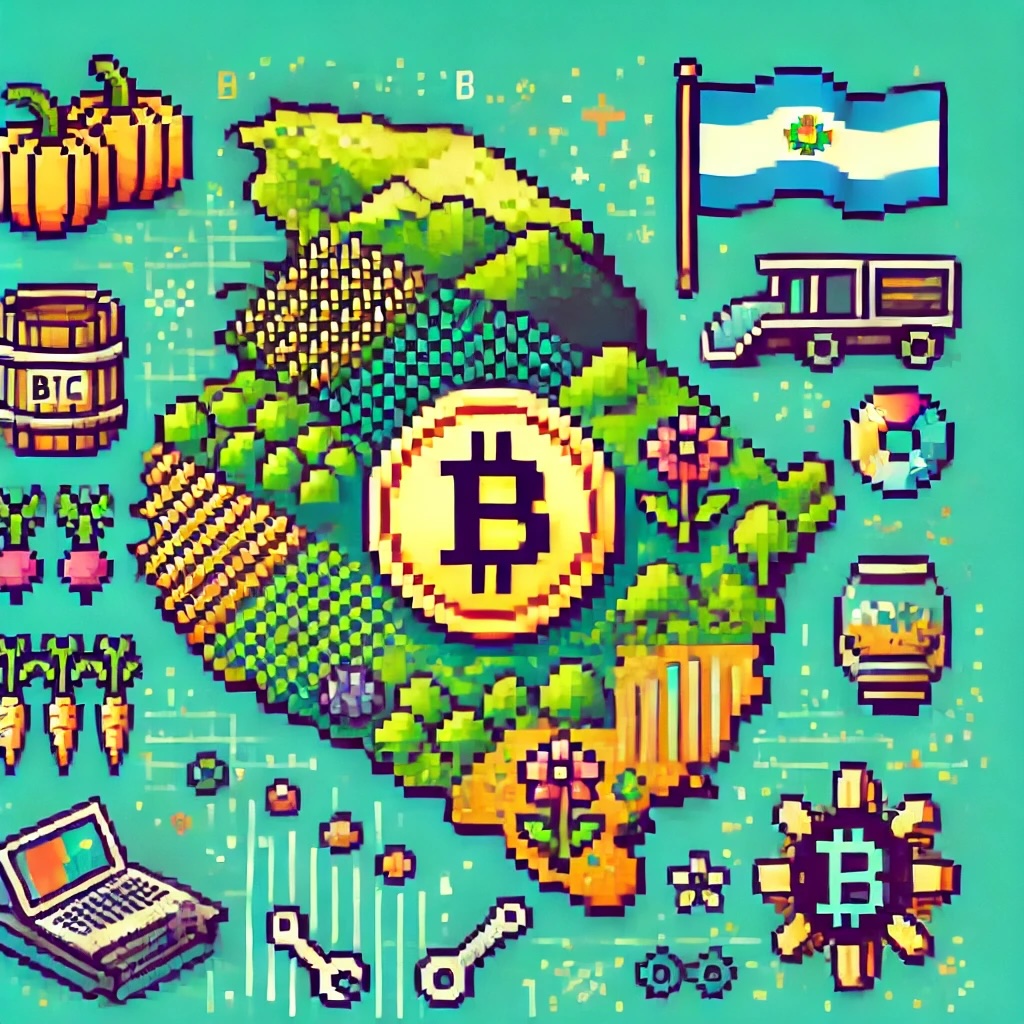
by Joche Ojeda | Jul 3, 2024 | A.I, Blockchain, El Salvador
El Salvador, my birthplace, has recently emerged as a focal point for technological innovation under the leadership of President Nayib Bukele. Born in Suchitoto during the civil war and now living as a digital nomad in Saint Petersburg, Russia, I have witnessed El Salvador’s transformation from a distance and feel compelled to share its story. This article is the first in a series exploring how blockchain technology, financial services, and artificial intelligence (AI) can help a small country like El Salvador grow.
Historical Context and Economic Challenges
El Salvador has faced significant economic challenges over the past few decades, including poverty, gang violence, and a heavy reliance on remittances from abroad. The economy has traditionally been rooted in agriculture, with coffee and sugar being key exports. However, President Bukele, who took office on June 1, 2019, has sought to address these challenges by diversifying the economy and embracing technology as a key driver of growth.
Bukele’s Vision for Economic Transformation
President Bukele’s administration has prioritized technological innovation as a catalyst for economic transformation. His vision is to modernize the country’s infrastructure and position El Salvador as a hub for technological innovation in Latin America. This vision includes the strategic shift from an agriculture-based economy to one focused on technology, financial services, and tourism. The goal is to create a more resilient and diverse economic base that can sustain long-term growth and development.
The Adoption of Bitcoin as Legal Tender
One of the most groundbreaking moves by Bukele’s administration was the introduction of the Bitcoin Law, passed by the Legislative Assembly on June 9, 2021. This law made Bitcoin legal tender alongside the US dollar, which had been the country’s official currency since 2001. The rationale behind this decision was multifaceted:
- Financial Inclusion: With a significant portion of the population lacking access to traditional banking services, Bitcoin offers an alternative means of financial inclusion.
- Reduction in Remittance Costs: Remittances make up a substantial part of El Salvador’s economy. Bitcoin’s adoption aims to reduce the high transaction fees associated with remittance services.
- Economic Innovation: By adopting Bitcoin, El Salvador aims to attract foreign investment and position itself as a leader in cryptocurrency and blockchain technology.
The implementation of Bitcoin involved launching the Chivo Wallet, a state-sponsored digital wallet designed to facilitate Bitcoin transactions. The government also incentivized adoption by offering $30 worth of Bitcoin to citizens who registered for the wallet.
Initial Reactions and Impact
The reaction to the Bitcoin Law was mixed. While some praised the move as innovative and forward-thinking, others raised concerns about the volatility of Bitcoin and its potential impact on the economy. Despite these concerns, the Bukele administration has remained committed to its Bitcoin strategy, continuing to invest in Bitcoin and integrate it into the national economy.
Digital Transformation Initiatives
I
n addition to Bitcoin adoption, El Salvador has partnered with global tech giants like Google to enhance its digital infrastructure. These partnerships aim to modernize government services, improve healthcare through telemedicine platforms, and revolutionize education by integrating AI-driven tools. For instance, Google’s collaboration with the Salvadoran government includes training government agencies on cloud technologies and developing platforms that allow interoperability between institutions.
Strategic Shift to Technology, Financial Services, and Tourism
President Bukele’s broader economic strategy involves shifting El Salvador’s economic focus from traditional agriculture to more dynamic and sustainable sectors like technology, financial services, and tourism. This shift aims to create high-value jobs, attract foreign investment, and build a more diversified economy.
- Technology: By investing in digital infrastructure and fostering a favorable environment for tech startups, El Salvador aims to become a regional tech hub.
- Financial Services: The adoption of Bitcoin and other fintech innovations is intended to transform the financial landscape, making it more inclusive and efficient.
- Tourism: Enhancing the country’s tourism sector, with initiatives to promote its natural beauty and cultural heritage, is another key pillar of Bukele’s economic strategy.
Conclusion and Future Prospects
El Salvador’s journey towards becoming a technological leader in Latin America is a testament to the transformative power of visionary leadership and innovative policies. Under President Bukele, the country has taken bold steps to embrace technology, from adopting Bitcoin to integrating AI into public services. This series of articles will delve deeper into these initiatives, exploring their impact, challenges, and the future prospects for El Salvador in the global technological landscape.
By understanding El Salvador’s technological revolution, we can gain insights into the potential for other nations to leverage technology for economic and social development. The next article in this series will focus on the detailed implementation of Bitcoin as legal tender, examining the steps taken by the Bukele administration and the outcomes observed so far.
This introductory article sets the stage for a comprehensive exploration of El Salvador’s technological transformation under President Bukele. The subsequent articles will provide in-depth analyses and propose potential AI legislation to ensure the country’s continued leadership in technology within Latin America.

by Joche Ojeda | Jun 10, 2024 | Blockchain, C#, Smart contracts, Stratis
Introduction
Blockchain technology has revolutionized various industries by providing a decentralized and secure way to manage data and transactions. At the heart of this innovation are smart contracts—self-executing contracts with the terms directly written into code. My journey into blockchain development began with the excitement of these possibilities, but it also came with challenges, particularly with the Solidity programming language. However, everything changed when I discovered the Stratis platform, which supports smart contracts using C#, making development much more accessible for me. In this article, I’ll share my experiences, challenges, and the eventual breakthrough that came with Stratis.
Challenges with Solidity
Solidity is the most popular language for writing smart contracts on Ethereum, but it has a steep learning curve. My background in programming didn’t include a lot of JavaScript-like languages, so adapting to Solidity’s syntax and concepts was daunting. The process of writing, testing, and deploying smart contracts often felt cumbersome. Debugging was a particular pain point, with cryptic error messages and a lack of mature tooling compared to more established programming environments.
The complexity and frustration of dealing with these issues made me seek an alternative that could leverage my existing programming skills. I wanted a platform that was easier to work with and more aligned with languages I was already comfortable with. This search led me to discover Stratis.
Introduction to Stratis
Stratis is a blockchain development platform designed to meet the needs of enterprises and developers by offering a simpler and more efficient way to build blockchain solutions. What caught my attention was its support for C#—a language I was already proficient in. Stratis allows developers to create smart contracts using C#, integrating seamlessly with the .NET ecosystem.
This discovery was a game-changer for me. The prospect of using a familiar language in a robust development environment like Visual Studio, combined with the powerful features of Stratis, promised a much smoother and more productive development experience.
Why Stratis Stood Out
The primary benefit of using C# over Solidity is the familiarity and maturity of the development tools. With C#, I could leverage the rich ecosystem of libraries, tools, and frameworks available in the .NET environment. This not only sped up the development process but also reduced the time spent on debugging and testing.
Stratis offers a comprehensive suite of tools designed to simplify blockchain development. The Stratis Full Node, for instance, provides a fully functional blockchain node that can be easily integrated into existing applications. Additionally, Stratis offers a smart contract template for Visual Studio, making it straightforward to start building and deploying smart contracts.
Another significant advantage is the support and community around Stratis. The documentation is thorough, and the community is active, providing a wealth of resources and assistance for developers at all levels.
Conclusion
Transitioning from Solidity to Stratis was a pivotal moment in my blockchain development journey. The challenges I faced with Solidity were mitigated by the ease and familiarity of C#. Stratis provided a robust and efficient platform that significantly improved my development workflow.
In the next article, I will dive into the practical steps of setting up the Stratis development environment. We’ll cover everything you need to get started, from installing the necessary tools to configuring your first Stratis Full Node. Stay tuned for a detailed guide that will set the foundation for your journey into C# smart contract development.

by Joche Ojeda | Apr 21, 2024 | Blockchain
Understanding Non-Fungible Tokens (NFTs)
What are NFTs?
Non-Fungible Tokens (NFTs) are a unique type of digital asset. Each NFT is distinct and cannot be replicated, which differentiates them from cryptocurrencies like Bitcoin or Ethereum, where each unit is identical.
What Can NFTs Represent?
NFTs can represent a wide array of digital and real-world items, including digital artwork, music, in-game items, videos, and even real-world assets like property rights.
Smart Contracts and Minting NFTs
The creation of NFTs involves the use of smart contracts, which are self-executing contracts with the terms of the agreement directly written into code. These smart contracts are used during the minting process, which is the term used for creating an NFT.
OpenZeppelin Contracts
OpenZeppelin provides a library of open-source smart contracts that are secure and have been thoroughly tested. These contracts are often used for creating NFTs and include implementations of standards like ERC-721 and ERC-1155. OpenZeppelin contracts are considered the gold standard for smart contract development and are used by many in the industry.
Fungible vs Non-Fungible Tokens
Fungible tokens are interchangeable and identical to each other. For instance, cryptocurrencies like Bitcoin or Ethereum are fungible tokens. If you have 1 Bitcoin, it’s the same as any other 1 Bitcoin.
On the other hand, non-fungible tokens (NFTs) are unique and cannot be interchanged with any other token. Each NFT has a distinct value based on its attributes. For example, consider a ticket to a concert. Each ticket (an NFT in this case) is unique based on its specific information such as the seat number, section, and row.
Minting an NFT
Minting an NFT is the process of creating a unique digital asset on a blockchain. This process involves transforming digital data into a unique digital asset, or NFT, that is recorded on the blockchain.
In conclusion, NFTs represent a new frontier in the digital world, offering a unique way to own and trade digital and real-world assets. Through the use of blockchain technology, smart contracts, and standards provided by libraries like OpenZeppelin, NFTs are changing the way we think about ownership and trade in the digital age.

by Joche Ojeda | Apr 19, 2024 | Blockchain
Blockchain in Healthcare: A Revolution in Medical Records Management
Introduction
In the digital age, the healthcare industry is constantly evolving. One of the most promising advancements is the application of blockchain technology, specifically Ethereum-like blockchains, in managing medical records. This technology offers a secure, decentralized, and transparent platform that can address many of the pressing issues in healthcare.
The Problem with Current Systems
The current healthcare systems are often fragmented and siloed, leading to incomplete records at the point of care and difficult access to patients’ own health information. This lack of interoperability between clinical data structures at both individual and community levels often results in patients receiving unnecessary medical services, such as repeated blood tests or physical examinations. Moreover, healthcare providers often do not have complete access to a patient’s medical records, which can lead to inadequate diagnosis or treatment.
The Blockchain Solution
Blockchain technology, particularly Ethereum-like blockchains, can revolutionize the healthcare industry by providing a secure and organized exchange of data within the medical community through shared repositories. These mechanisms aim to protect patient records and anonymity, making doctors more aware of their patients’ medical histories.
Blockchain technology alleviates the reliance on a centralized authority to certify information integrity and ownership, as well as mediate transactions and exchange of digital assets. It possesses key properties, such as immutability, decentralization, and transparency.
Use Cases of Blockchain in Healthcare
Patient Record Management
One of the most promising use cases of blockchain in healthcare is patient record management. Blockchain can enable access to longitudinal, complete, and tamper-aware medical records that are stored in fragmented systems in a secure and pseudo-anonymous fashion. This can grant patients complete ownership of their health records so that they can give or revoke access to their data at any time.
Drug Supply Chain Tracking
Blockchain can also be used to tackle the illicit shipment or unlawful processing of controlled drugs. It offers an opportunity to register, provide a chronology, and show the identity details of drugs in an immutable database. This secure monitoring of the supply chain and the traceability of medical products is important to avoid the sale of illegal or illicit drugs.
Conclusion
The application of Ethereum-like blockchain in healthcare, particularly in managing medical records, presents a promising solution to the current challenges in the healthcare industry. By providing a secure, decentralized, and transparent platform, blockchain technology can revolutionize the way we manage and access medical records, ultimately leading to improved patient care and health outcomes.

by Joche Ojeda | Apr 16, 2024 | Blockchain
Understanding Ethereum and Smart Contracts
The Ethereum Virtual Machine (EVM) is akin to a global, decentralized computer that exists across thousands of individual computers worldwide. This “computer” executes programs known as smart contracts, which are automated contracts whose terms are written directly into code, allowing them to operate independently of intermediaries.
How Smart Contracts Work
Smart contracts streamline processes such as digital agreements and transactions. For example, in a leasing agreement, a smart contract can automate monthly rent payments from a tenant’s digital wallet to a landlord’s wallet, adhering to the terms with precision and reliability. This automation is set into motion through the following steps:
- Creation: A developer writes the contract in a specific programming language.
- Deployment: The contract is uploaded to the Ethereum blockchain.
- Execution: It is then executed automatically by the EVM upon being triggered by transactions.
Comparing Blockchain Platforms
While Ethereum was the pioneer, other blockchains like Solana, Polygon, and TON (The Open Network) also support smart contracts, each offering unique benefits.
Solana
- High Speed: Solana processes thousands of transactions per second, offering a significant speed advantage over Ethereum.
- Low Costs: Its efficiency ensures that transaction fees are minimal, fostering cost-effective operations.
- Scalability: The design allows scaling with hardware advancements, maintaining high-speed capabilities.
Polygon
- Ethereum Compatibility: Acts as a side-chain to Ethereum, facilitating faster and cheaper transactions.
- Low Transaction Fees: By processing transactions off the main Ethereum chain, it reduces costs significantly.
- Speed: Provides quicker transaction processing times, enhancing the user experience.
TON (The Open Network)
- Speed and Efficiency: Designed for quick processing at low costs, suitable for high-load applications.
- Versatility: Supports features like user-friendly wallet services and decentralized storage.
- User-Friendliness: Focuses on accessibility, aiming to bring blockchain to the mainstream.
These platforms enhance user experience through faster transactions and reduced costs, support high transaction volumes, and offer security and reliability due to their decentralized nature. Each blockchain serves different use cases, allowing developers to choose based on their specific needs for efficiency and functionality.




